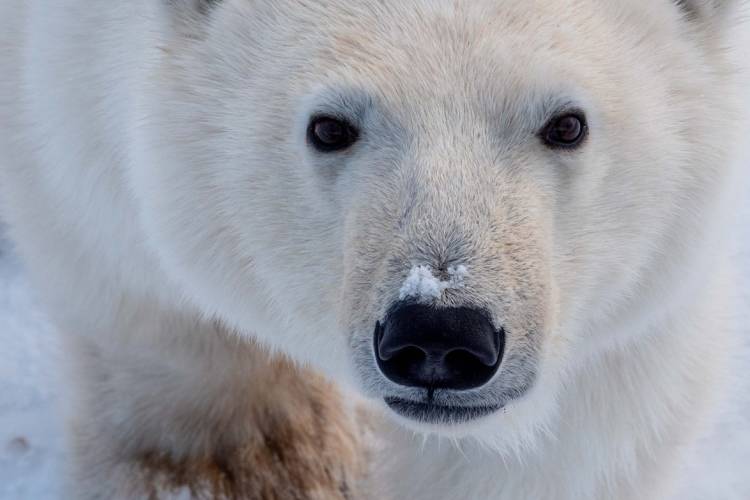Activity 3C: Reflect

Photo: BJ Kirschhoffer / Polar Bears International
A Species in Decline
How do you discuss the status of polar bears?
Step One
Review the following information.
When a scientist says polar bear populations are declining, this means that polar bear individuals are dying and/or not thriving. This is imagery and descriptions that no one likes to see, hear or think about. However if we don't talk about this, the reality of what is happening with polar bears will not be understood and taking action will not occur. It is not recommended, however, to use the same language or methods for communicating about polar bears in a warming Arctic with the scientific community (including yourselves) as one would for communicating with the general public.
The observations of a declining population: What does it really mean for polar bears if sea ice is declining? How are they impacted and what are scientists seeing?
Due to sea ice decline we have seen:
Declining growth rates
Declining physical condition
Declining survival
Declining reproduction
Unusual feeding
Drowning
Increased Cannibalism
Unusual movements
Loss of access to denning areas
Declining population size
Population Decline as it Relates to the Ecoregions
It is easiest to explain the location of sea ice and impact on polar bears by learning about the changes in sea ice in the already mentioned 4 ecoregions (instead of in the 19 subpopulations). Below, you'll read about each ecoregion and the threats faced by the polar bears that live there.
Seasonal Ice Ecoregion – Seasonal sea ice areas occur at the southern extreme of the polar bear's range and include places like Canada's Hudson Bay, where the ice melts each summer and the bears must wait for freeze-up in the fall until they can hunt again. Polar bears in these seasonal areas are some of the most endangered, with longer and longer ice-free seasons pushing the bears to be on land for increased periods of time and testing the limits of their fat reserves.
Polar Basin Divergent Ice Ecoregion – In these areas, sea ice forms along the shore but then retreats, especially in summer. As the sea retreats farther and farther from shore in a warming Arctic, these polar bears are faced with a choice of coming ashore—fasting until the ice returns in the fall—or swimming long, exhausting distances to reach the remaining pack ice. Ice that's located far offshore, however, often covers unproductive parts of the sea, so bears in these areas may successfully complete a marathon swim, but still not find any seals to hunt. Polar bears that live in these areas are at great risk: from longer and longer swims, prolonged fasting periods, and encounters with humans on shore. Our chief scientist, Dr. Steven Amstrup, recently testified before Congress about the Arctic National Wildlife Refuge and its coastal plain–a pristine wilderness and important denning site for polar bears that is now under threat from proposed oil and gas activity. Take a look for a view of how mums and cubs are faring in parts of this ice region in the video below.
Polar Basin Convergent Ice Ecoregion – Sea ice formed in other parts of the Arctic collects along the shore of these habitats, providing polar bears with access to seals. Polar bears in these areas are faring well now, but scientists predict that ice in these areas will disappear within 75 years—and, with it, resident polar bear populations—unless action is taken to reduce CO2.
Archipelago Ice Ecoregion – Islands in the Canadian High Arctic and Greenland are far enough north that sea ice remains along the coast even in summer, providing hunting for the bears. This ecoregion is predicted to be the last stronghold for polar bears, but it, too, is expected to melt within 100 years unless greenhouse gas emissions are greatly reduced.
Polar Bear Population Distribution by Sea Ice Ecoregion
Seasonal Ice Ecoregion: Baffin Bay, Davis Strait, Foxe Basin, Southern Hudson Bay, Western Hudson Bay
Polar Basin Divergent Ice Ecoregion: Barents Sea, Chukchi Sea, Kara Sea, Laptev Sea, Southern Beaufort Sea
Polar Basin Convergent Ice Ecoregion: Eastern Greenland, Northern Beaufort Sea, Queen Elizabeth Islands
Archipelago Ice Ecoregion: Gulf of Boothia, Kane Basin, Lancaster Sound, M'Clintock Channel, Norwegian Bay, Viscount Melville Sound
Now take a moment to explore results from a paper, released July 20, 2020 in Nature Climate Change, where scientists forecast the future of polar bear populations based on two different carbon emissions scenarios.
Step Two
Read Melting Under Pressure: The Real Scoop On Climate Warming and Polar Bears.
Watch the above video of a Polar bear presentation by Dr. John Whiteman, PBI's Chief Research Scientist. For context, he was an invited speaker for the Economic Roundtable of San Francisco. A little after the 50min mark in the recording, he takes some questions and did a great job of navigating pushback from a climate denier. We offer this example to illustrate that folks at all points in their careers and in all settings may experience pushback, and how valuable it can be to listen, but not be distracted by tangential topics.
Guiding Questions:
What are signs of decline?
What is confusing about the status of polar bears?
How would you explain to someone that climate change is NOT good for polar bears?
Share a comment in the Discord community in response to one of the questions.

Photo: Mike Lockhart / Polar Bears International
Finished?
Continue on to Activity 3D – Apply.

Photo: Kieran McIver / Polar Bears International










